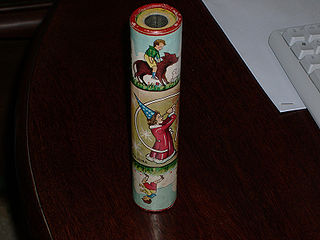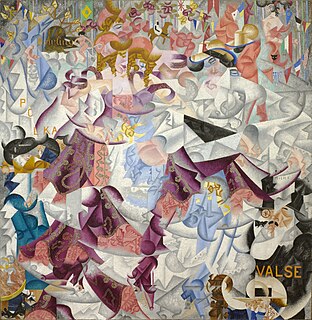Abstract film or absolute film is a subgenre of experimental film and a form of abstract art. Abstract films are non-narrative, contain no acting and do not attempt to reference reality or concrete subjects. They rely on the unique qualities of motion, rhythm, light and composition inherent in the technical medium of cinema to create emotional experiences. [1] The French Cinéma pur movement is closely related to absolute film, originating in the same period and based on very similar concepts, but its films are seldom fully abstract; they usually contain recognizable figuration.
Experimental film, experimental cinema or avant-garde cinema is a mode of filmmaking that rigorously re-evaluates cinematic conventions and explores non-narrative forms and alternatives to traditional narratives or methods of working. Many experimental films, particularly early ones, relate to arts in other disciplines: painting, dance, literature and poetry, or arise from research and development of new technical resources.

Abstract art uses a visual language of shape, form, color and line to create a composition which may exist with a degree of independence from visual references in the world. Western art had been, from the Renaissance up to the middle of the 19th century, underpinned by the logic of perspective and an attempt to reproduce an illusion of visible reality. The arts of cultures other than the European had become accessible and showed alternative ways of describing visual experience to the artist. By the end of the 19th century many artists felt a need to create a new kind of art which would encompass the fundamental changes taking place in technology, science and philosophy. The sources from which individual artists drew their theoretical arguments were diverse, and reflected the social and intellectual preoccupations in all areas of Western culture at that time.
Non-narrative film is an aesthetic of cinematic film that does not narrate, or relate "an event, whether real or imaginary". The aesthetic is non-representational. It is usually a form of art film or experimental film, not made for mass entertainment.
Contents
- History
- Before cinema
- Earliest examples
- The absolute film movement
- 1930s to 1940s
- 1950s to 1960s
- Musical influence
- Examples
- See also
- References
The history of abstract film often overlaps with the concerns and history of visual music. Some films are very similar to music visualization, especially when electronic devices (for instance oscilloscopes) were used to generate a type of motion graphics in relation to music.
Visual music, sometimes called colour music, refers to the use of musical structures in visual imagery, which can also include silent films or silent Lumia work. It also refers to methods or devices which can translate sounds or music into a related visual presentation. An expanded definition may include the translation of music to painting; this was the original definition of the term, as coined by Roger Fry in 1912 to describe the work of Wassily Kandinsky. There are a variety of definitions of visual music, particularly as the field continues to expand. In some recent writing, usually in the fine art world, visual music is often confused with or defined as synaesthesia, though historically this has never been a definition of visual music. Visual music has also been defined as a form of intermedia.

Music visualization or music visualisation, a feature found in electronic music visualizers and media player software, generates animated imagery based on a piece of music. The imagery is usually generated and rendered in real time and in a way synchronized with the music as it is played.

An 'oscilloscope', previously called an 'oscillograph', and informally known as a scope or o-scope, CRO, or DSO, is a type of electronic test instrument that graphically displays varying signal voltages, usually as a two-dimensional plot of one or more signals as a function of time. Other signals can be converted to voltages and displayed.
Many abstract films have been made with animation techniques. The distinction between animation and other techniques can be rather unclear in some films, for instance when abstract objects were filmed in motion or with camera movement when very similar results could have been obtained with stop motion techniques.

Animation is a method in which pictures are manipulated to appear as moving images. In traditional animation, images are drawn or painted by hand on transparent celluloid sheets to be photographed and exhibited on film. Today, most animations are made with computer-generated imagery (CGI). Computer animation can be very detailed 3D animation, while 2D computer animation can be used for stylistic reasons, low bandwidth or faster real-time renderings. Other common animation methods apply a stop motion technique to two and three-dimensional objects like paper cutouts, puppets or clay figures.

Stop motion is an animated-film making technique in which objects are physically manipulated in small increments between individually photographed frames so that they will appear to exhibit independent motion when the series of frames is played back as a fast sequence. Dolls with movable joints or clay figures are often used in stop motion for their ease of repositioning. Stop-motion animation using plasticine figures is called clay animation or "clay-mation". Not all stop motion, however, requires figures or models: stop-motion films can also be made using humans, household appliances, and other objects, usually for comedic effect. Stop motion using humans is sometimes referred to as pixilation or pixilate animation.










